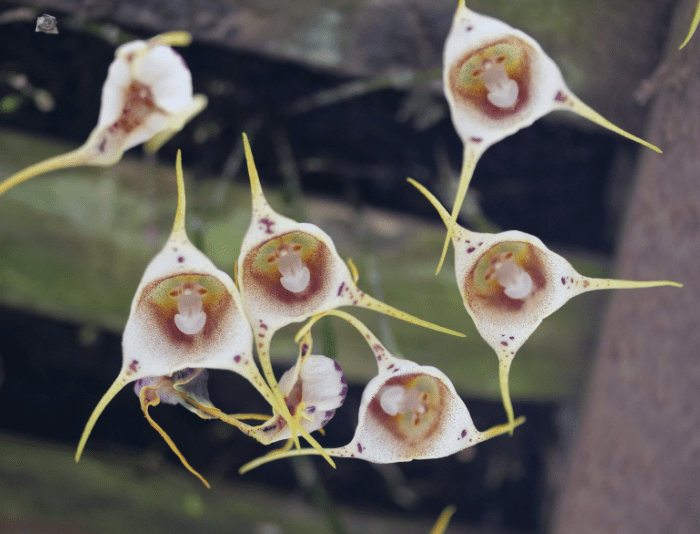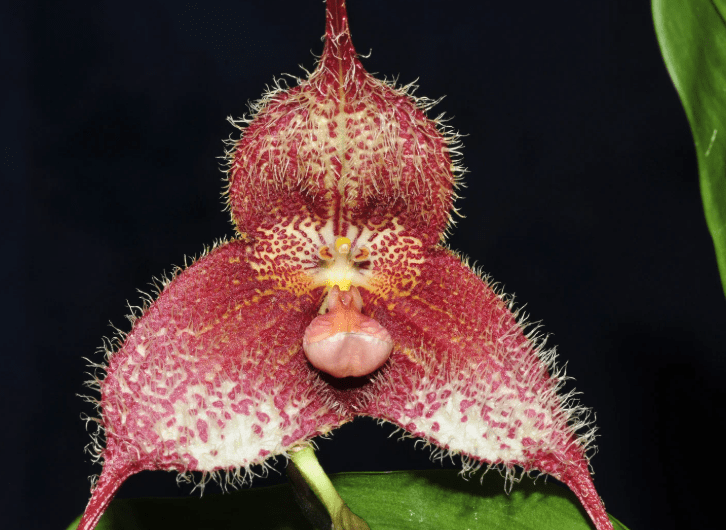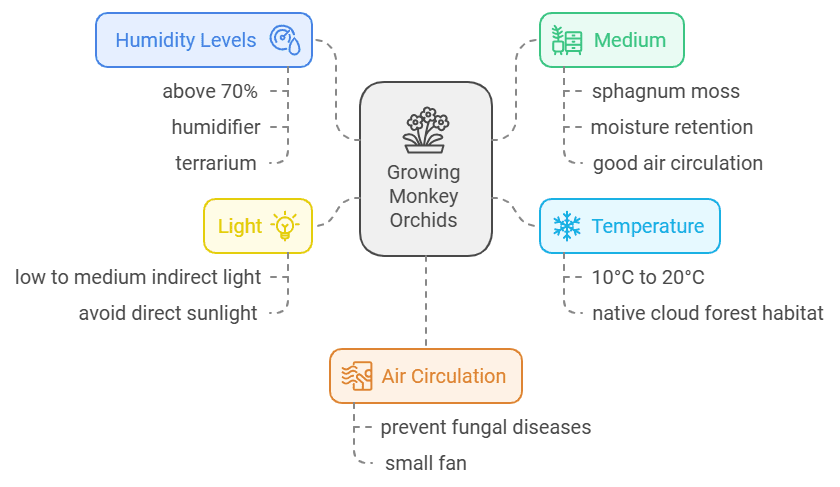What is Monkey Orchid?
The Monkey Orchid, scientifically known as Dracula simia, is one of nature’s most captivating flowers. With petals that strikingly resemble a monkey’s face, this rare orchid has fascinated botanists and plant enthusiasts alike.

Nestled in the cloud forests of South America, particularly in Ecuador, Peru, and Colombia, the Monkey Orchid thrives in its natural habitat where high humidity and cool temperatures prevail.
| Monkey Orchid Facts | |
|---|---|
| Scientific Name | Dracula simia |
| Common Name | Monkey Orchid |
| Family | Orchidaceae |
| Genus | Dracula |
| Natural Habitat | Cloud forests of Ecuador, Peru, and Colombia |
| Growing Conditions | High humidity, cool temperatures, low light |
| Blooming Season | Year-round under optimal conditions |
| Reference | Royal Botanic Gardens, Kew |
The Enigmatic Appearance of the Monkey Orchid
The Monkey Orchid’s unique appearance is attributed to its petals and sepals forming patterns that mimic a monkey’s face. This resemblance is so uncanny that it often takes observers by surprise. The flower’s coloration ranges from pale hues to deep maroon, adding to its mysterious allure. The detailed “face” is not just a trick of the eye but a complex arrangement of floral structures that serve specific functions in the plant’s reproduction.
Habitat and Distribution
Found at elevations between 1,000 to 2,000 meters, the Monkey Orchid flourishes in the damp, cool environments of South America’s cloud forests. These regions are characterized by high humidity levels and consistent night temperatures, essential for the orchid’s growth. The dense canopy of the forests provides the low light conditions the orchid prefers, while the sphagnum moss that covers tree trunks offers the perfect medium for its roots.
The Dracula Genus: A World of Intriguing Orchids

The Monkey Orchid belongs to the Dracula genus, which comprises over 120 species. The name “Dracula” means “little dragon,” referring to the long, fang-like spurs of the petals. Other notable species in this genus include Dracula gigas and Dracula Vampira, each with their unique features and captivating appearances.
Growing Monkey Orchids at Home

Cultivating Monkey Orchids requires replicating their natural habitat as closely as possible:
- Humidity Levels: Maintain high humidity, preferably above 70%. Using a humidifier or placing the orchid in a terrarium can help achieve this.
- Temperature: Keep temperatures cool, especially at night, ideally between 10°C to 20°C (50°F to 68°F).
- Light: Provide low to medium indirect light. Avoid direct sunlight, which can scorch the leaves.
- Medium: Use sphagnum moss or a mix that retains moisture yet allows good air circulation.
- Air Circulation: Ensure good air movement to prevent fungal diseases. A small fan can be beneficial.
Challenges in Cultivation
Growing Monkey Orchids can be challenging due to their specific requirements. They are sensitive to temperature fluctuations and require consistent care. Issues like root rot can occur if the medium is too wet without adequate air circulation. However, for orchid enthusiasts, the reward of seeing the unique bloom is worth the effort.
Adaptations to Cloud Forest Life
The cloud forests where Monkey Orchids reside are enveloped in persistent fog and moisture. To adapt, these orchids have developed:
- Epiphytic Growth: They grow on other plants, primarily trees, without parasitizing them, allowing access to better air circulation.
- Moss Associations: Their roots intertwine with sphagnum moss, which retains moisture and nutrients.
- Unique Pollination Strategies: Some Dracula species emit scents that attract specific pollinators like fungus gnats.
Importance in the Orchidaceae Family
Within the Orchidaceae family, one of the largest and most diverse plant families, Monkey Orchids stand out due to their distinctive morphology and ecological adaptations. Their unique pollination mechanisms and intricate flower structures make them a subject of interest in botanical research.
Conservation Status
Due to habitat loss from deforestation and climate change, some species within the Dracula genus face threats in the wild. Conservation efforts by botanical gardens and environmental organizations are essential to preserve these fascinating plants for future generations.
Other Notable Species: Dracula gigas

Another captivating species is Dracula gigas, known for its large, bat-like flowers. Like the Monkey Orchid, it thrives in high humidity and cool temperatures, contributing to the diversity and intrigue of the Dracula genus.
Cultural Significance and Popularity
The Monkey Orchid has gained popularity beyond the botanical world, often featured in media for its extraordinary resemblance to a monkey’s face. This has made it a symbol of the exotic and mysterious aspects of nature, sparking interest in orchid cultivation and conservation.
FAQs
Q: Why is it called the Monkey Orchid?
A: It’s named for its flowers, which remarkably resemble a monkey’s face due to the arrangement of petals and sepals.
Q: Can I grow a Monkey Orchid at home?
A: Yes, but it requires replicating its natural cool and humid environment, which can be challenging.
Q: Where can I find Monkey Orchids in the wild?
A: They are native to the cloud forests of Ecuador, Peru, and Colombia at high elevations.
Q: What is the Dracula genus?
A: It’s a genus of orchids known for unique and often eerie floral appearances, including species like Dracula simia (Monkey Orchid).
Q: How often do Monkey Orchids bloom?
A: Under optimal conditions, they can bloom year-round, but they often have peak blooming periods in their natural environment.
Q: What challenges do Monkey Orchids face in the wild?
A: Habitat loss due to deforestation and climate change significantly threaten their natural populations.
Q: Are Monkey Orchids available commercially?
A: They are available from specialized orchid growers but may require permits to import or export due to conservation regulations.
Q: Can Monkey Orchids be grown in terrariums?
A: Yes, terrariums can provide the high humidity and controlled environment suitable for growing Monkey Orchids.
Q: What is the significance of the name Dracula?
A: The genus name Dracula means “little dragon” in Latin, referring to the dramatic appearance of the flowers, which often have spurs resembling fangs.
Q: What role does sphagnum moss play in cultivation?
A: Sphagnum moss retains moisture and provides a breathable medium for the roots, mimicking the orchid’s natural growing conditions.

























